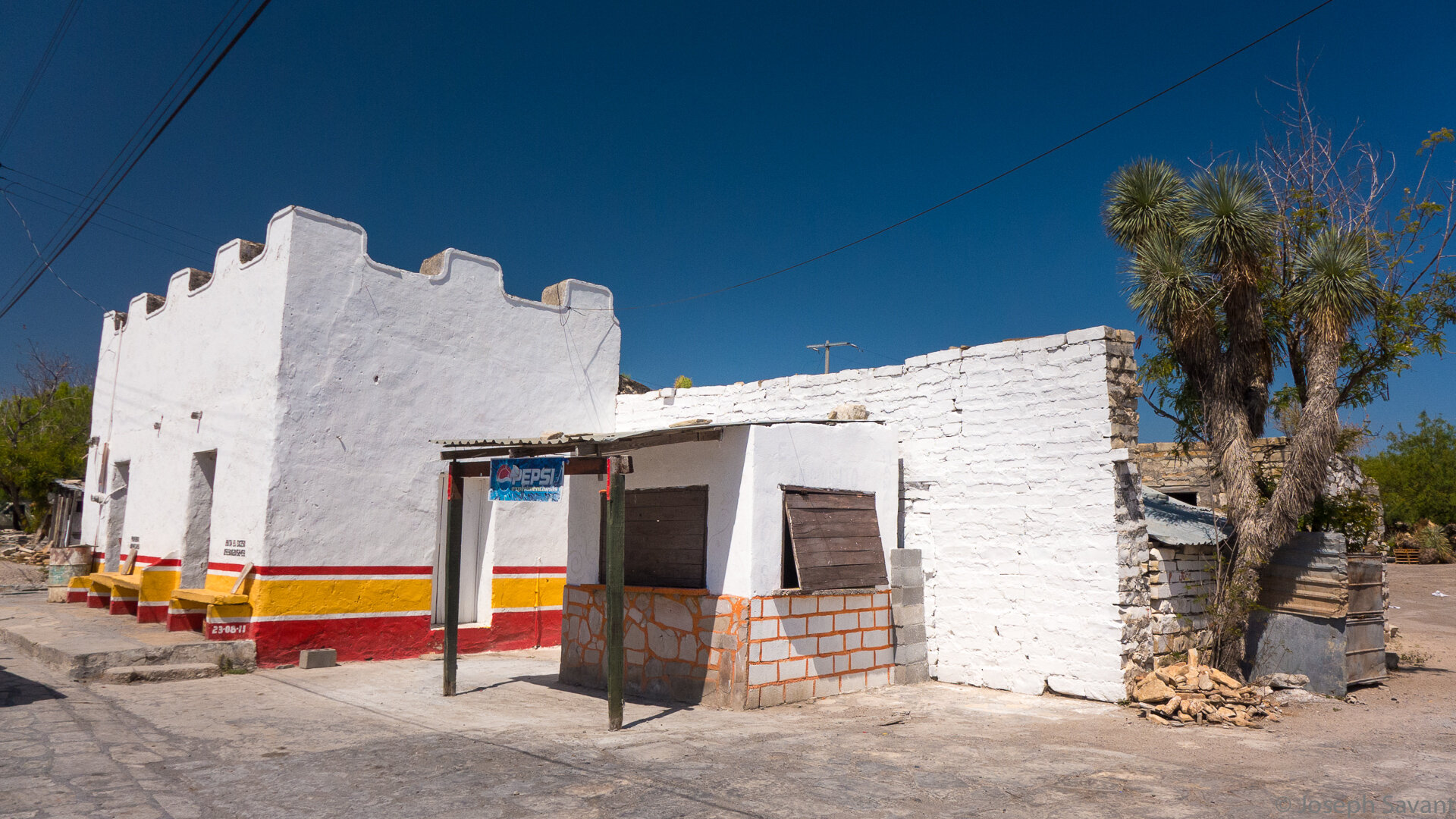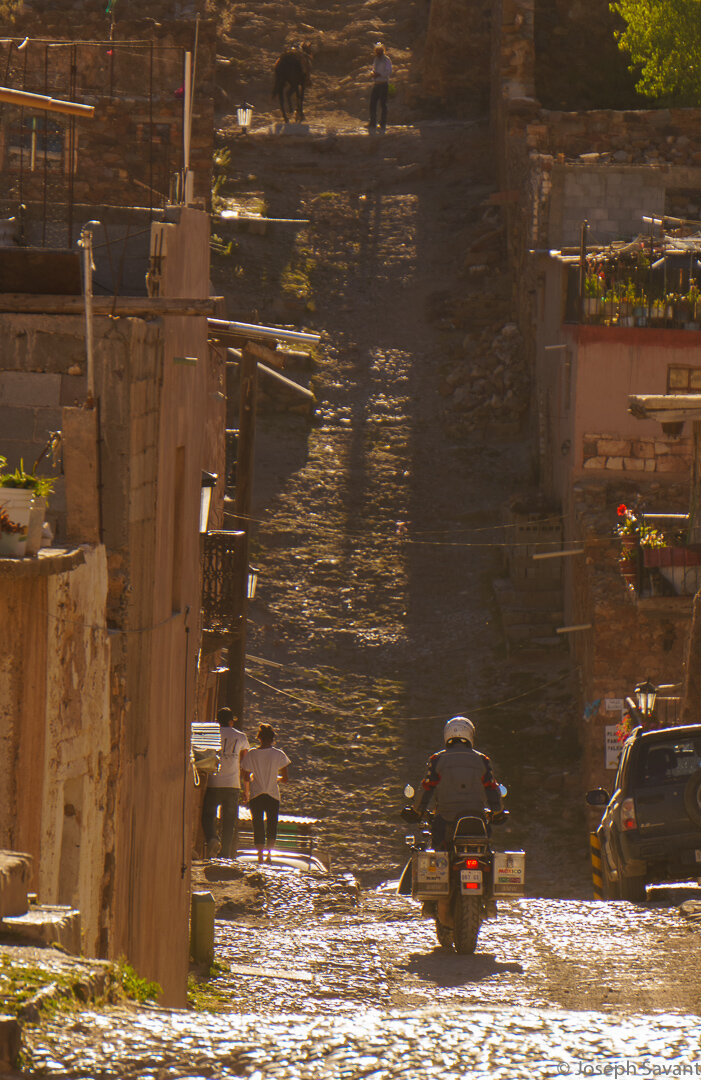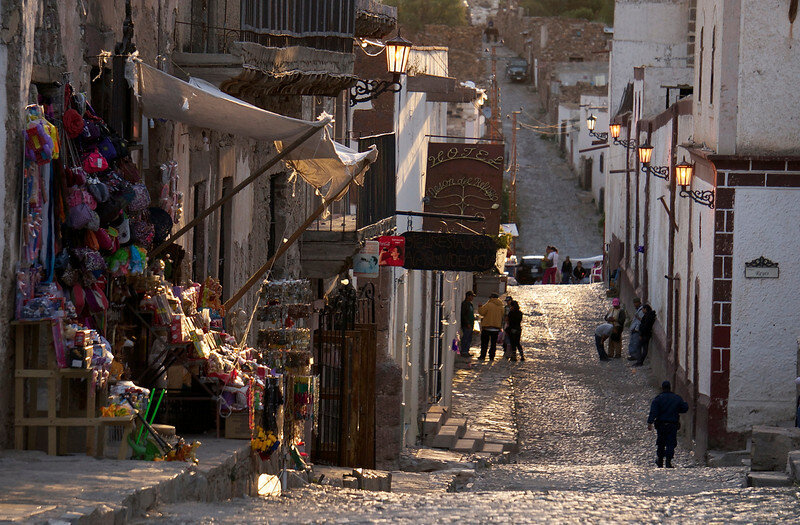Recently, I got a call from my friend Hank, the owner of “MotoHank”, a BMW motorcycle repair shop in Dilley, Texas, asking if I'd be interested in a quick trip into Mexico to Real de Catorce in the Mexican state of San Luis Potosi.
We'd ridden through there the previous October on a trip deep into Mexico to the Michoacan region. and ’twas a magical place. Hank's shop in Dilley puts him on a route from Mexico and South America into the U. S. and he gets a lot of international riders coming through. As well, Hank has spent years exploring Mexico and regions further south, racking up half a million miles on his 1995 R1100GS.
Being the trip junkie I am, I told him "YES" and that I'd spank anyone who tried to stop me. Hank had been tasked with testing a new suspension design for Touratech, an aftermarket company who produce expensive upgraded products for adventure motorcycles and he wanted to run it through everything possible in a short time frame - high speed freeway travel, heavy off-road usage, slow maneuvering and anything else that came along. Real De Catorce and the surrounding area would be a good place, including many miles of heavy duty cobblestone and rough dirt roads, not to mention the “topes” or as we call them, speedbumps, which are everywhere in Mexico.
Anyway it was a great excuse to go.
In my usual way, I waited until the day before leaving to frantically prep the motorcycle and get packed. I did a fair job of packing light, but I too, have been testing and refining some camera and video gear for travel and took a variety, so I had a bunch of extra crap.
Leaving my house outside Kerrville at about dark-thirty Saturday night, I reached Dilley and Hank's shop late in the evening. We grabbed a bite and then I crashed on his couch. Up early, we hit the road for Laredo, the International Bridge, and the potential hours of waiting to get the appropriate forms for Immigration and Vehicle permits. Unfortunately the 6 month window of my previous permits had expired a couple of weeks before this trip and we'd both had to run down to the border to turn them in. That now meant going through the process again as opposed to merely crossing and heading for the interior.
My 1998 R1100GS had been having a butt-fest of bad fuel mileage and I had not found the answer. Whereas I typically got about 40 mpg at highway speeds, my run to Dilley had only made 25 mpg, a real concern when your tank size is roughly 4.5 gallons of useable fuel. That night I pulled fuse # 5 and left it out overnight, doing a Motronic reset once again in the hopes it might make a difference. To Laredo, I managed to get an amazing 32 mpg. Blech. To some this may seem a non-issue, but where I ride, 150 miles or more to gas can be common. When your tank warning light pops on at 110 miles, it gets a little old...
At the border, we were lucky and managed to get simultaneous green lights at the entry meaning we didn’t have to stop and be inspected. Inmigración for travel visa and Aduana for temporary vehicle permits went reasonably quickly as well and we were cruising out of Nuevo Laredo and south by about 10:30 am.
This time, Nuevo Laredo lacked the sandbagged machine gun nests and heavy military presence we'd seen the previous October. It still feels good to get away from the border town and south as fast as possible however. Though we had to make serious time since we needed to cover about 500 miles that day, we took a few "libre" or free roads on the way rather than the tollways or "cuota", to see a bit more and get some photos of general random coolness.
We stopped at an old store for a Coca Cola break and shot a few photos.
Inside, an old man with rutted face and cowboy hat made the perfect model, but he began getting nervous and wigged out when Hank asked about taking his picture.
I was afraid to take a pic in the store, having visions of the old man snapping and coming at me with a machete - albeit slowly - but I did get a picture of the family quarters in the back
We scooted out and later Hank shared that folks get nervous when they're being photographed, as it can be common for the Mexican mafia to come in and photograph the possessions of owners, then return for a shakedown later.
All that drama and a bag of chips
We eventually passed the hazy, smoggy mountains surrounding Monterrey and squeezed through the mountain pass past Saltillo, catching the tollway southwest towards the next large town of Matehuala. My gas mileage improved as the elevation increased and the air was cool, roaring, rumbling and popping through my earplugs as we raced past abandoned roadside cafés, the crumbling facades painted brightly in super-saturated and fading colors of Corona beer, Carta Blanca or pretty much any paint that was available.
We passed endless roadside tire repair shacks, "Vulka" scrawled on walls or boards to advertise their service, horses and herds of goats grazing loose in the median between highway lanes, ropes of garlic and bags of onions stacked along the expressway, each vendor hoping to sell something in the desolate desert landscape. Thoughts of the difficulty of life for the locals, their hopes and needs pinned on sacks of onions and ropes of garlic along a blistering highway, with identical competitors spaced each half-mile down the highway. One had to keep concentration up, as the vendors often set their 50 lb bags well into the highway lane…
The tollways in Mexico are generally in excellent condition, the one we were on very fast and high with sweeping curves as it intertwined with the edges of the mountains to our left, that incredible sense of flying on the ground in beautiful sweeping motions flooding your senses.
After a couple of gas stops and cold belts of Coca Cola, we eventually reached the unmarked cut-off road for Cedral, a little town north of Matehuala and sped along the narrow blacktop road, rounding a curve at speed and sudden panic braking as a slew of goats spewed from the creosote bushes onto the road into our midst.
Passing through the edge of the little town of Cedral, we eventually reached the road to our destination of Real de Catorce. The road through the valley up to the old town, which sits above 9,000 feet, is made of rough cobblestone, approximately 14 miles long, and straight as an arrow for sections. It winds through the desert valley and then climbs high up the mountainside.
Real De Catorce means “Royal Fourteen”, and though legend speaks of the native Indians killing 14 Spanish conquistadors for which it was named, in reality it speaks of the fourteen mountains in the range, designated as royal property for the King of Spain since they were laden with silver, and of course, resultant silver mines for the king. The little town was at one point the richest in Mexico due to silver production and figured prominently in Mexican independence for that reason.
The remains of old stone buildings from that period litter the valley below, long ago abandoned. Now Real has become a time capsule and “Pueblo Magico” by the government, but it’s also famous for the indigenous Huichol indians, who made and still make annual pilgrimages to a sacred peak nearby known as the “Quemado”. The valley floor below the peak is known for peyote, the hallucinogenic plant that is still a part of the indigenous rituals, not to mention others who come to the area to experiment with the drug. Real is also known as the location for the classic Humphrey Bogart film “The Treasure of the Sierra Madre” and more recently, the Brad Pitt and Julia Roberts film “The Mexican”.
The road takes a bit to get used to, as at first the large rutted cobblestones cause the motorcycle to wander and wobble, but one eventually settles into a rhythm. Can’t say the same for anything in the motorcycle cases, which will vibrate badly for the entire ride.
We stopped briefly in the remains of the small community of “La Luz” which sits at the base of the mountain, scrambling around piles of rubble for photos, neither of which is lacking in Mexico.
El Cerdo
El Cerdo Rojo
Continuing on up the cobblestones that climb the mountainside to the old mine tunnel one must pass through to enter Real De Catorce, we stopped a couple of times to take in the vistas of the valley below.
At the top of the climb, we were stopped by the guard and waited at the entrance to the tunnel leading through the mountain and into the town on the other side. The tunnel is an old mine tunnel that eventually was enlarged and made to pass through the entire mountain. It is only wide enough for one vehicle, so a guard is posted at each end to let traffic pass one-way only. My odometer showed it to be almost 2 miles in length.
All the charm in the world, including but not limited to, four silver front teeth… but Hank wasn’t buying from the vendor.
The 20 peso toll is paid to the tunnel guardian and then the progression into darkness and the damp, cold humidity of the 2 mile long tunnel. As you exit and burst into the blinding sunlight of a setting sun, the eyes adjust and it seems you've taken a time tunnel into the past. Steep and narrow cobble streets, stone buildings from the 17 and 1800's, street vendors in colorful stalls, horses and roosters, a mesmerizing mixture of light, shadow, stone and people.
On our previous one-day visit a few months earlier we'd stayed at a nice hotel, due mainly to the availability of a semi-level section of sidewalk upon which to park. The streets are very steep and narrow and it can be almost impossible to find a parking spot for a motorcycle. Simply negotiating the streets can be a real challenge in itself. On big heavy bikes, one has to use momentum when climbing and rounding a tight corner to find pedestrians or a stopped vehicle can literally leave you with no place to get a foot down on the very uneven cobblestone streets. The stones are highly polished from wear, and if wet, it would be a nightmare trying to ride there. Hank had visited once in a 4WD SUV after a rain, and the vehicle ended up sliding all the way down a steep street before crashing into a wall. Needless to say it would be a similar experience on a motorcycle.
Parking excuse or not, the hotel was an amazing little place, beautifully built within and upon the ruins of an old stone building. The architect did a great job of incorporating modern into the rustic stone and the rooms were very nice. It felt great to get off the bike and stretch, even better to breath in the cool mountain air of a new world, the setting sun raking ancient stone walls and polishing the cobble streets.
The area attracts Bohemian travelers, who often live in abandoned ruins and partake of the peyote in the valley below.
Dinner that evening was well appreciated, "pollo a la parilla" in my case, and mixed with nice conversation with a couple of other travelers at a nearby table, a girl from Belgium and another from Holland. Politics, travel and the beauty of Real were discussed, stopping just shy of religion.
Reviewing the days images…
More tomorrow mi amigos...


































